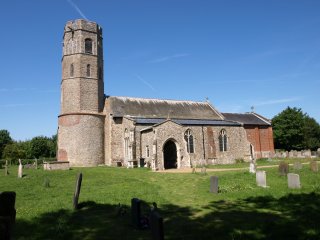History of St Margaret's Church
Much restored over the centuries, the church of St Margaret in Topcroft still has many features of interest and antiquity.
The exterior
The lofty tower is a fascinating mixture of styles and additions. Some have dated the round base as Norman and the first two octagonal stages as 13th-century additions. A recent study suggests, however, that the three lower stages were built at the same time (possibly early in the 14th century), with the tower being independently constructed against an existing church. A fourth stage, the belfry, was added in the 15th century. It’s crowned by an embattled parapet with a frieze of fleurons and fine grinning gargoyles.
In 1983 the church tower was given a new lead roof. The rendering was stripped and the stonework was re-pointed. During this work, six lancet windows were uncovered and reinstated, making eight in all. The tower has three bells, but only one is currently in use.
The interior
Much of the nave and the south aisle is in the Perpendicular style. In 1712 the church was greatly restored and the brick chancel was also added at this time.
There are carved medieval heads at the lower gable end, with a group of three heads together at the east end of the south aisle. The south porch has a niche for a holy water stoup in an exterior wall. High on its south-east buttress it has a hole (for a peg) which would have formed part of a 'mass dial'. Decorative heads flank the entrance arches.
The interior has a 14th-century arcade which leans outwards. The south aisle has large Perpendicular windows. The rood loft stairs remain in the north wall. The font dates from the 15th century. There is a trefoil-headed piscina (for washing communion vessels) at the east end of the south aisle: this suggests that there was once an altar there. The Royal Arms are of King George III (1760-1820) and the hanging wooden hatchments are of the Smyth family of Topcroft Hall. Near the chancel arch is a small but attractive tablet (inscribed in Latin) to Richard Wilton, who died in 1637.
Restoration history
In 1861 the chancel was re-seated and most of the windows renewed. Further work on the chancel was done in 1876 when the then fashionable decoration with Bible texts was added. A substantial programme of repair, improvement and redecoration has been carried out more recently, including a new heating system. In 2003 pews were removed from the south aisle and a new pamment floor was laid, making this area more adaptable for services, concerts and meetings. Topcroft church is used for the main Easter services by the Group.
Part of the churchyard is a conservation area and in spring it is a mass of primroses and orchids.

